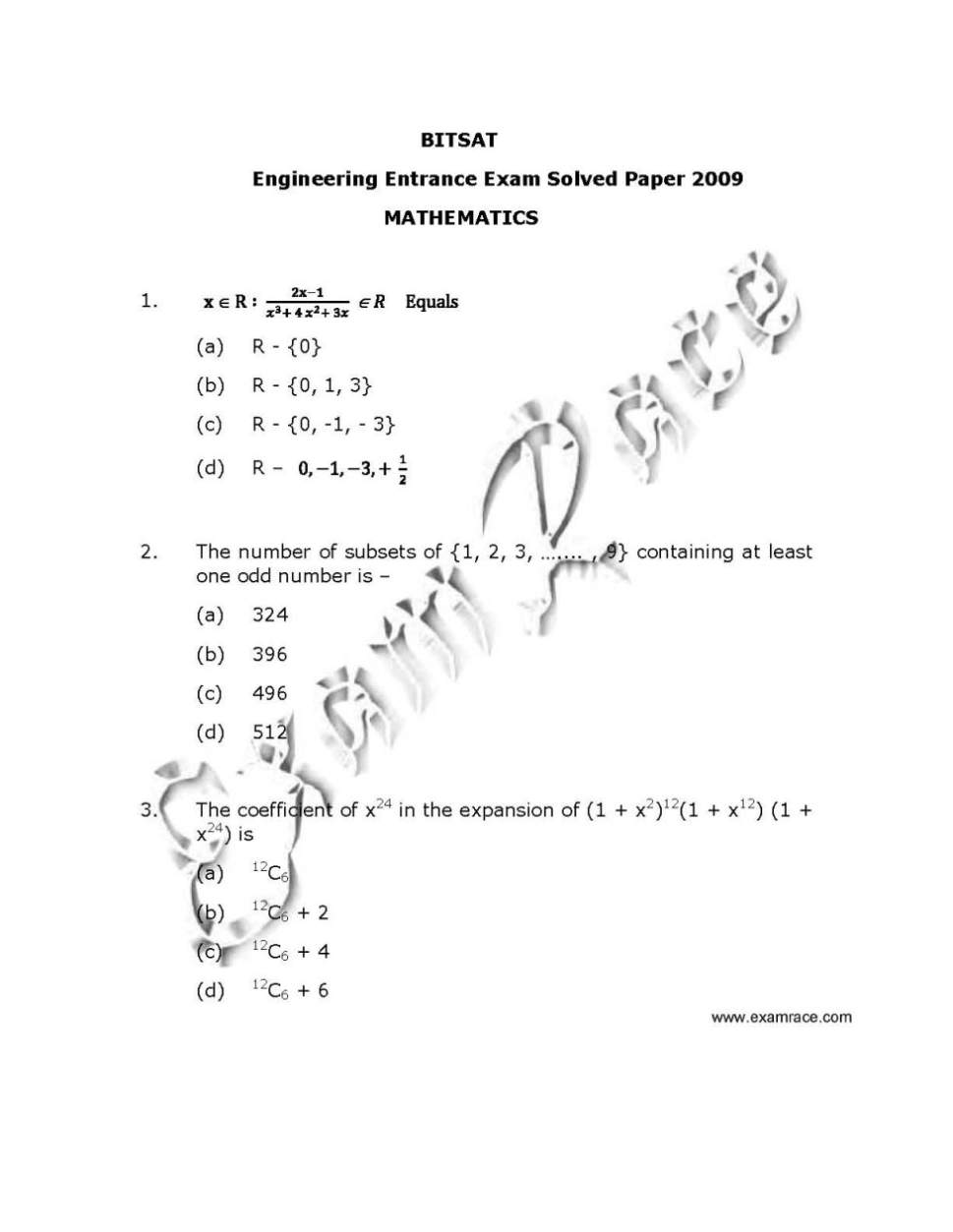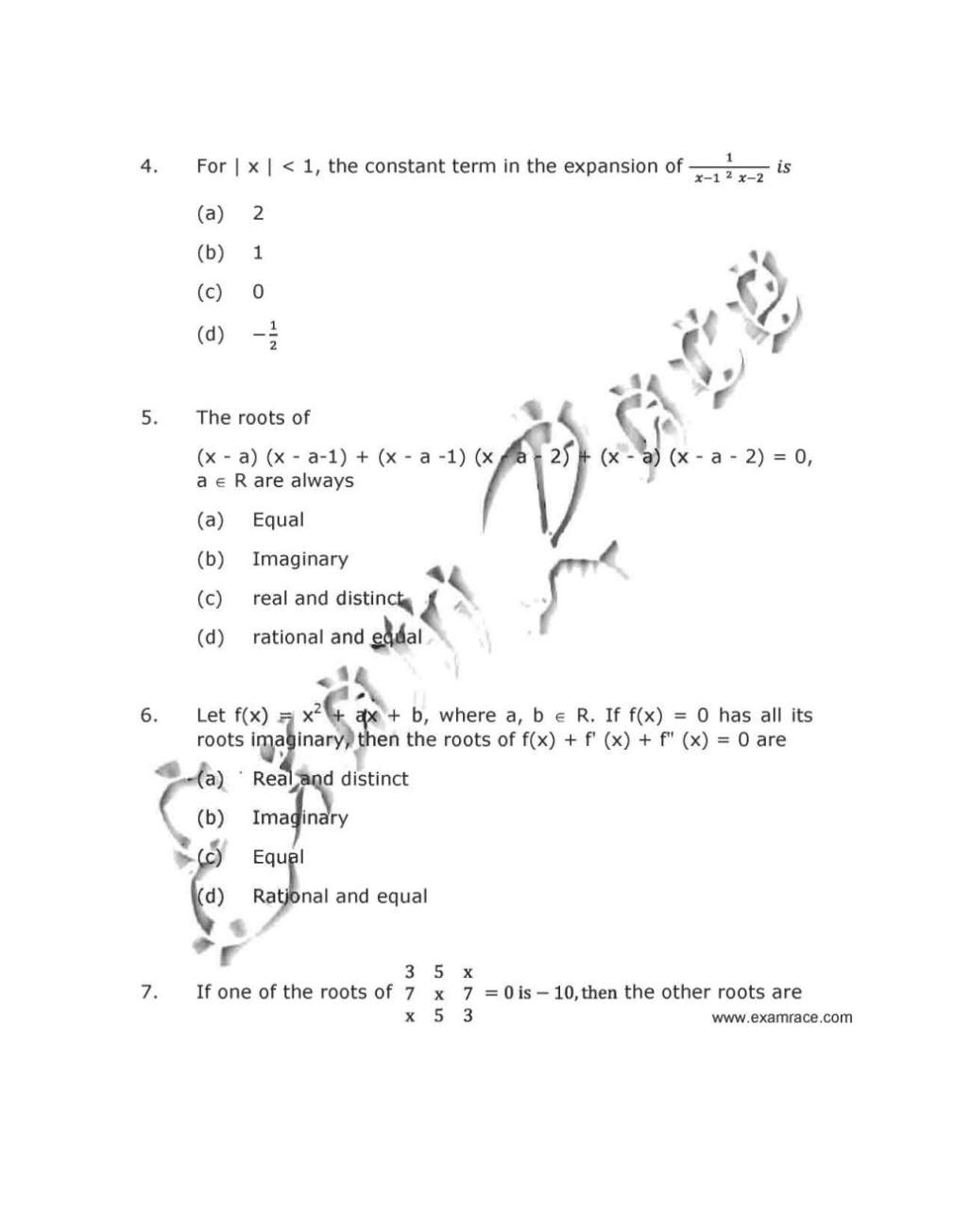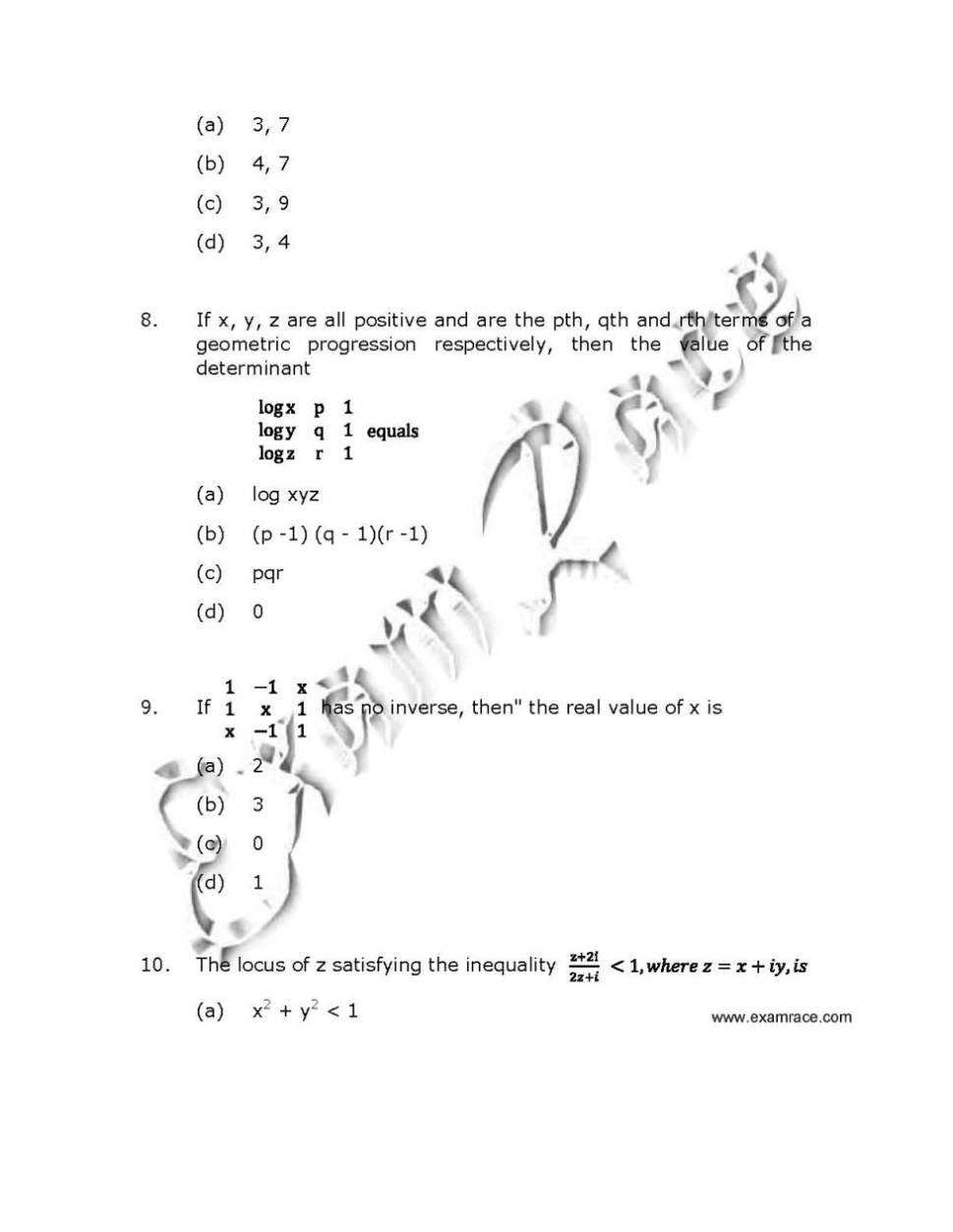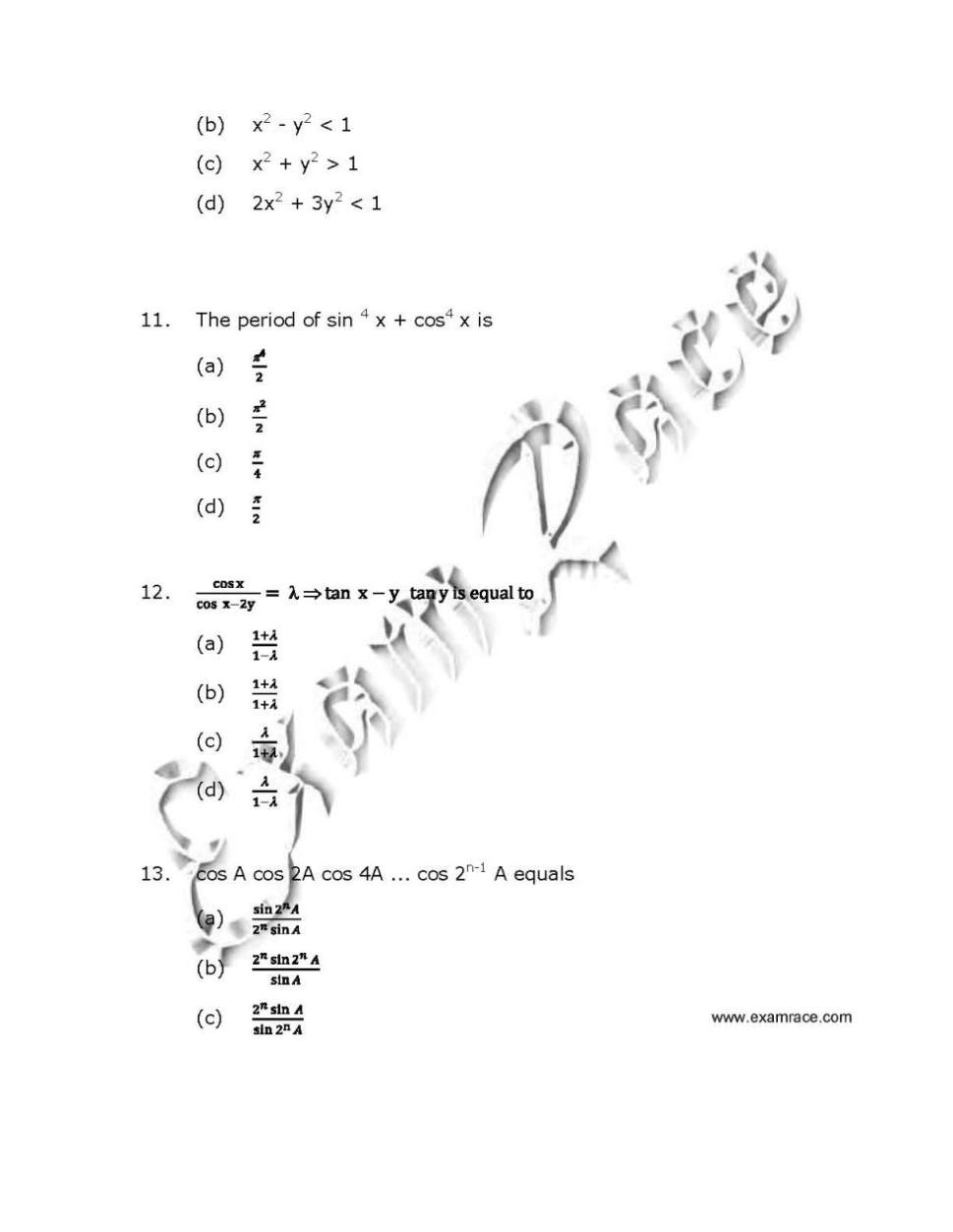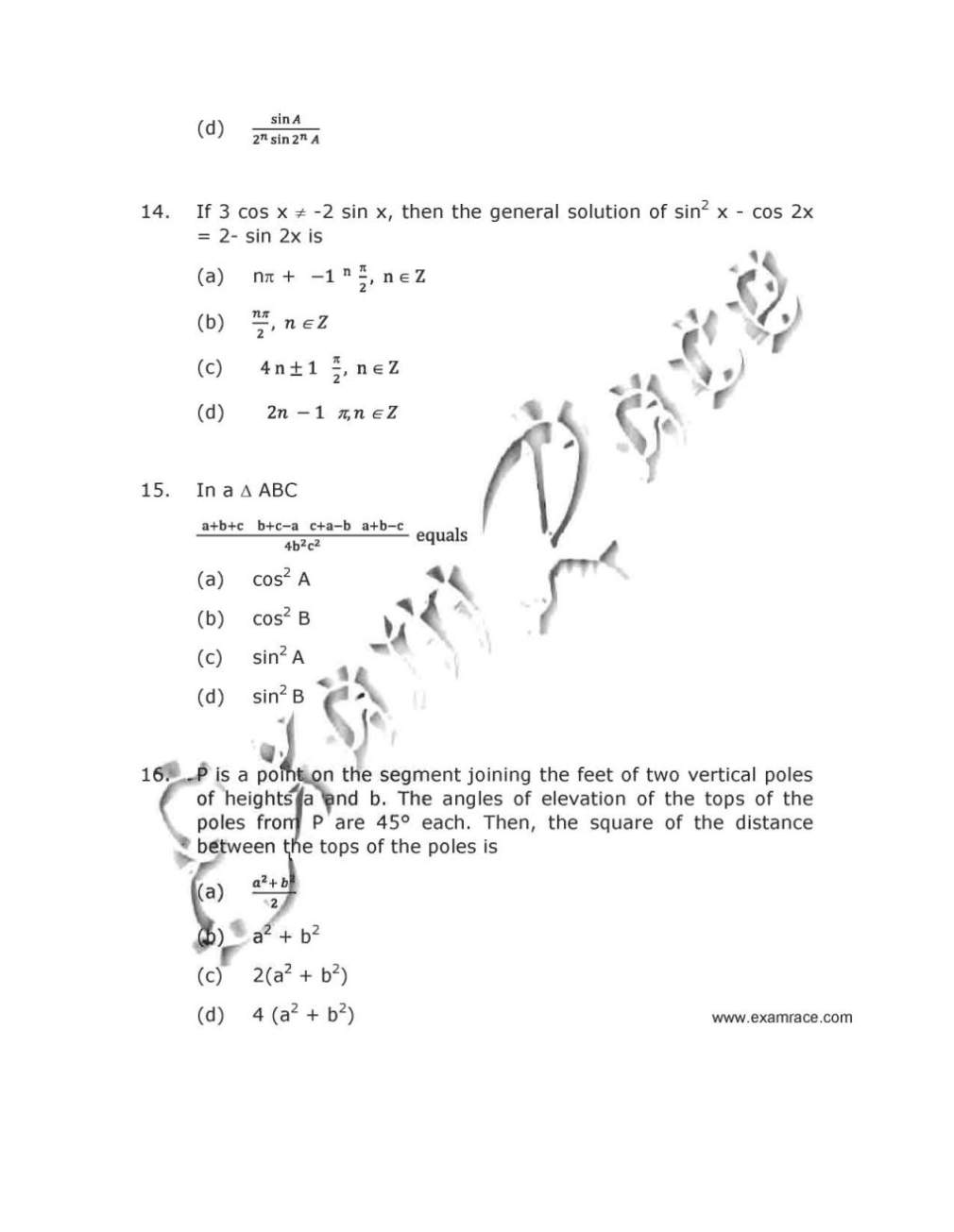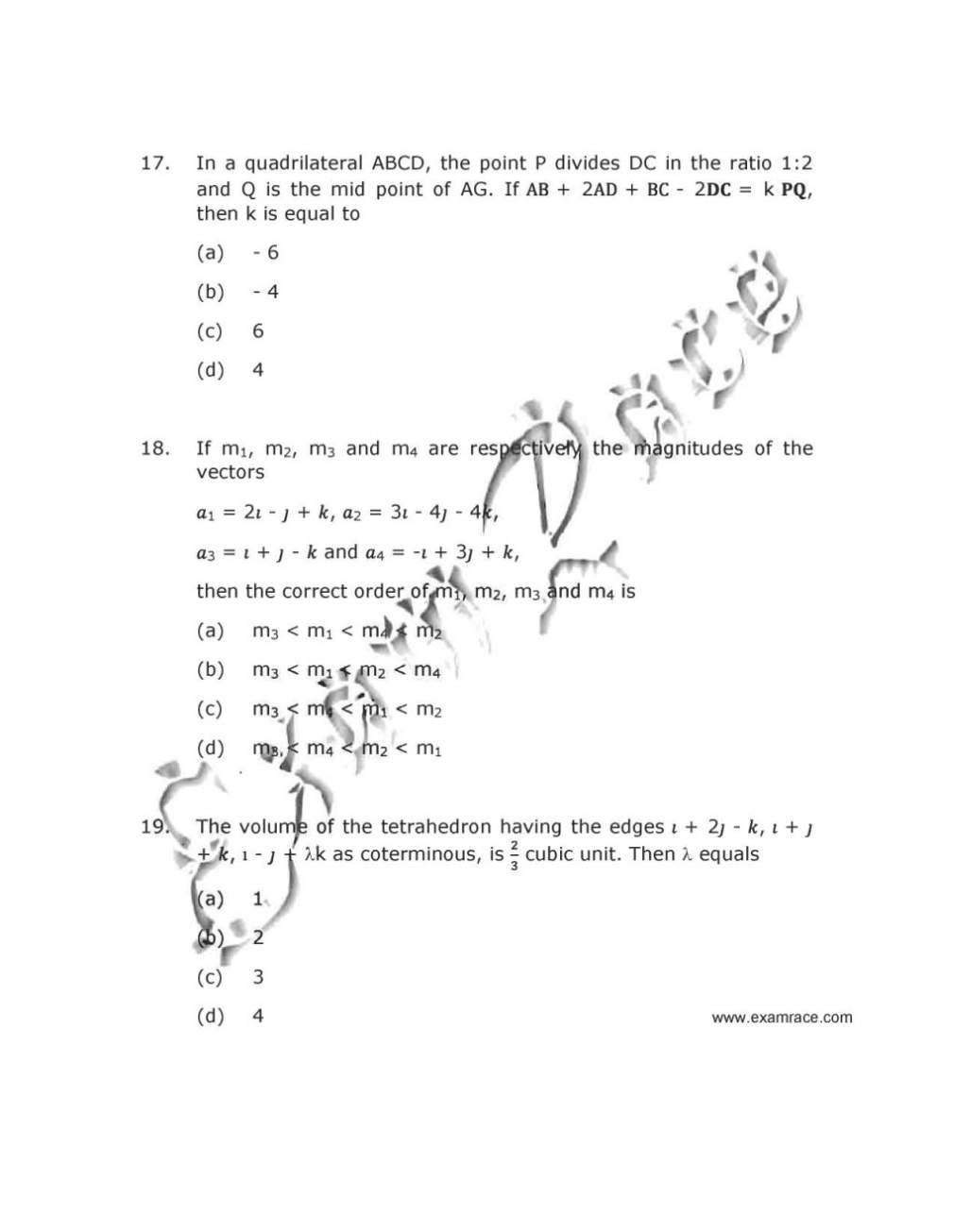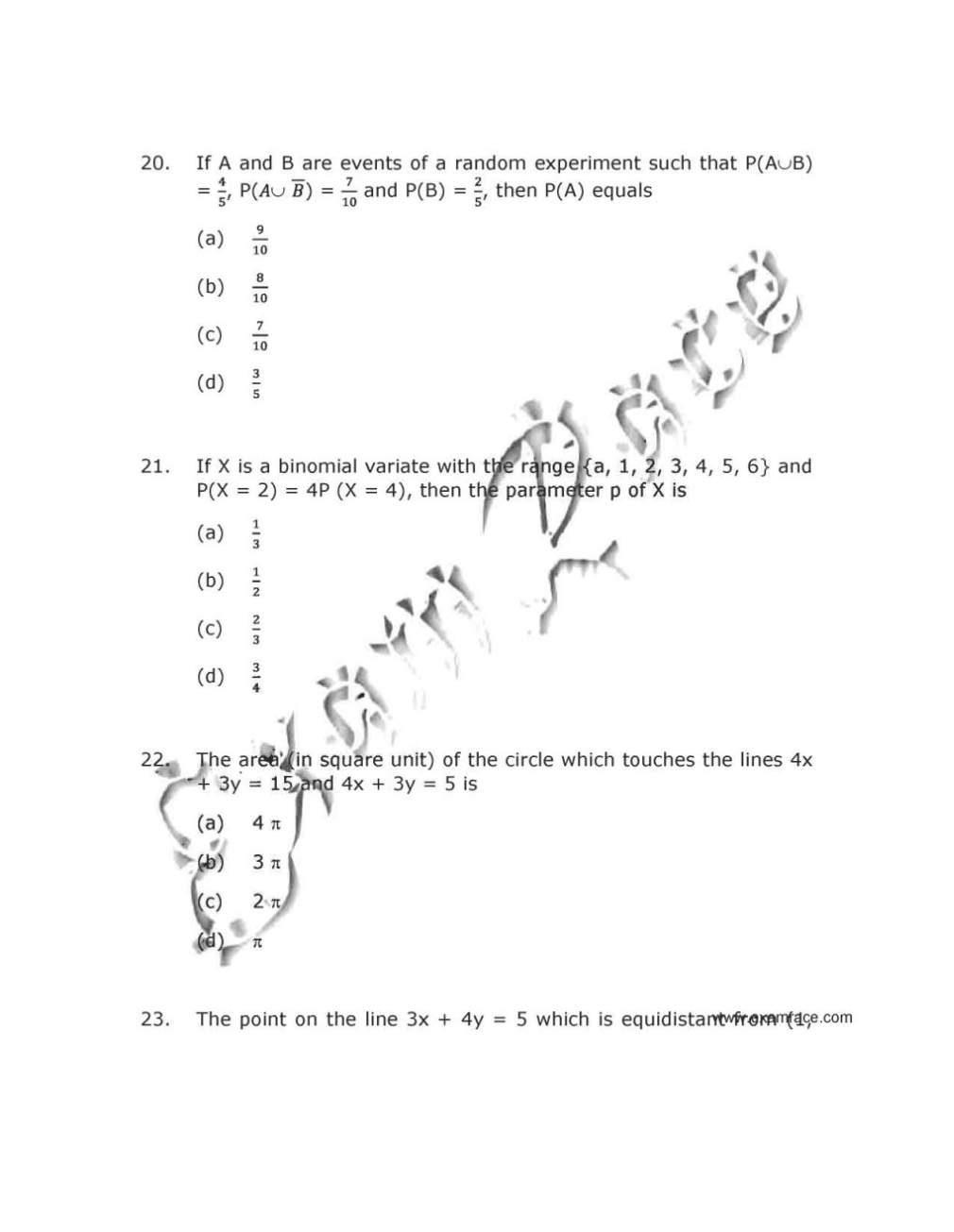This is the BITSAT old question paper:
BITSAT old question paper
. If α, β are the roots of ax2 + bx + c = 0 then (-1/α), (-1/β) are the roots of
(a) ax2 – bx + c = 0
(b) cx2 – bx + a = 0
(c) cx2 + bx + a = 0
(d) ax2 – bx – c = 0
2. The number of real roots of the equation
(x – 1)2 + (x – 2)2 + (x – 3)2 = 0 is
(a) 1
(b) 2
(c) 3
(d) None of these
3. If S is the set containing values of x satisfying [x]2 – 5[x] + 6 ≤ 0 , where [x] denotes GIF then S contains
(a) (2, 4)
(b) (2, 4]
(c) [2, 3]
(d) [2, 4)
4. Seven people are seated in a circle. How many relative arrangements are possible?
(a) 7!
(b) 6!
(c) 7P6
(d) 7C6
5. In how many ways can 4 people be seated on a square table, one on each side?
(a) 4!
(b) 3!
(c) 1
(d) None of these
6. Four different items have to be placed in three different boxes. In how many ways can it be done such that any box can have any number of items?
(a) 34
(b) 43
(c) 4P3
(d) 4C3
7. What is the probability that, if a number is randomly chosen from any 31 consecutive natural numbers, it is divisible by 5?
(a) (6/31)
(b) (7/31)
(c) (6/31) or (7/31)
(d) None of these
8. The mean of a binomial distribution is 5, then its variance has to be
(a) > 5
(b) = 5
(c) < 5
(d) = 25
9. If a is the single A.M. between two numbers a and b and S is the sum of n A.M 's between them, then S/A depends upon
(a) n, a, b
(b) n, a
(c) n, b
(d) n
10. 21/4 41/8 81/16 161/32 .. upto ∞ equal to
(a) 1
(b) 2
(c) 3/2
(d) 5/2
11. The odds in favour of India winning any cricket match is 2 : 3. What is the probability that if India plays 5 matches, it wins exactly 3 of them?
12. For an A.P., S2n = 3 Sn. The value of (S3n/Sn) is equal to
(a) 4
(b) 6
(c) 8
(d) 10
13. 1 + sin x + sin2 x + sin 3 x + ... = 4 + 2√3, 0 < x < π, x ≠ π/2 then x =
(a) (π/6, π/3)
(b) (π/6, 5π/6)
(c) (π/3, 2π/3)
(d) (π/3, 5π/6)
14.
(a) x2
(b) x
(c) loge(1 + x)
(d) loge x2
15. The ends of a line segment are P(1, 3) and Q(1, 1). R is a point on the line segment PO such that
PR : QR = 1 : λ. If R is an interior point of the parabola y2 = 4x, then
(a) λ ∈ (0, 1)
(b) λ ∈ (-3/5, 1)
(c) λ ∈ (-1/2, -3/5)
(d) None of these
16. Set of values for which is true is
(a) φ
(b) nπ + (π/4), n ∈ Z
(c) (π/4)
(d) 2nπ + π/4, n ∈ Z
17. The distance between the lines 3x + 4y = 9 and 6x + 8y + 15 = 0 is
(a) 3/10
(b) 33/10
(c) 33/5
(d) None of these
18. Let A = (3, -4), B(1, 2) and P = (2k - 1, 2k + 1) is a variable point such that PA + PB is the minimum. Then k is
(a) 7/9
(b) 0
(c) 7/8
(d) None of these
19. The length of the y-intercept made by the circle x2 + y2 - 4x 6y - 5 = 0 is
(a) 6
(b) √14
(c) 2√14
(0 3
20. If x + y = k is normal to y2 =12x, then k =
(a) 3
(b) 6
(c) 9
(d) None of these
21. The number of values of c such that the straight line y = 4x + c touches the curve (x2/4 + y2 = 1)
(a) 1
(b) 1
(c) 2
(d) infinite
22.
(a) 0
(b) √2
(c) 1/2
(d) 1/√2
23. Locus of the point z satisfying Re (i/z) = k is a non-zero real number, is
(a) a straight line
(b) a circle
(c) an ellipse
(d) a hyperbola
24. The points of z satisfying arg lies on
(a) an arc of a circle
(b) a parabola
(c) an ellipse
(d) a straight line
25. The coefficients of the (3r)th term and the (r + 2)th term in the expansion (1 + x)2n are equal, then
(a) n = 2r
(b) n = 3r
(c) n = 2r + 1
(d) None of these
26.
(a) 2e
(b) e
(c) e - 1
(d) 3e
27. If a = 13, b = 12, c = 5 in ∠ABC, then sin(A/2) =
(a) (1/√5)
(b) (2/3)
(c) √(32/35)
(d) (1/√2)
28. 2tan-1 (3/4)
(a) sin-1(24/25)
(b) sin-1(12/13)
(c) cos-1(24/25)
(d) cos-1(12/13)
29. Two pairs of straight lines have the equations y2 + xy - 12x2 = 0 and ax2 + 2hxy + by2 = 0. One line will be common among them if
(a) a = -3(2h + 3b)
(b) a = 8(h - 2b)
(c) a = 2 (b + h)
(d) Both (a) and (b)
30. If a circle passes through the point (3, 4) and cuts x2 + y2 = 9 orthogonally, then the locus of its centre is 3x + 4y = λ X. Then λ =
(a) 11
(b) 13
(c) 17
(d) 23
31. For what value of x, the matrix A is singular
(a) x = 0, 2
(b) x = 1, 2
(c) x = 2, 3
(d) x = 0, 3
32. 1f 7 and 2 are two roots of the following equation then its third root will be
(a) -9
(b) 14
(c) 1/2
(d) None of these
33. Period of f(x) = sin4 x cos4 x
(a) π
(b) π/2
(c) 2π
(d) None of these
34. The range Of loge (sin x)
(a) (- ∞, ∞)
(b) (- ∞, 1)
(c) (- ∞, 0]
(d) (- ∞, 0)
35.
(a) (1/8)
(b) (-1/8)
(c) (2/3)
(d) (3/2)
36. Let y = log sin(x2), 0 < x ≤ π/2;. The value of (dy/dx) at x = (√π/2) is
(a) 0
(b) 1
(c) (π/-4)
(d)√π
37. For the curve x = t2 – 1, y = t2 – t tangent is parallel to x-axis where
(a) t = 0
(b) t = (1/√3)
(c) t = 1/2
(d) t = (-1/√3)
38. f(x) = x3 – 6x2 + 12x – 16 is strictly decreasing for
(a) x ∈ R
(b) X ∈ R – {1}
(c) x ∈ R+
(d) x ∈ (φ)
39. The value of b for which the function f(x) = sinx – bx + c is a strictly decreasing function ∀ x ∈ R is
(a) b ∈ (-1, 1)
(b) b ∈ (-α, 1)
(c) b ∈ (1, α)
(d) b ∈ [1, α)
40. Maximum value of the expression 2 sinx + 4 cosx + 3 is
(a) 2√5 + 3
(b) √5 - 3
(C) √5 + 3
(d) None of these
41. If sin θ = 3 sin(θ + 2 α) , then the value of tan(θ + α)+ 2 tanα is
(a) 3
(b) 2
(c) 1
(d) 0
42.
(a) 10
(b) (1/10)
(c) 1
(d) -1
43. If √1 + x2 + √1 + y2 = a then find (dy/dx) =
44. Length of the subtangent to the curve y = ex/a is
(a) ex/a
(b) a
(c) 2/a
(d) None of these
45. The value of c of mean value theorem when f(x) = x3 - 3x - 2 in [-2, 3] is
(a) (√7/3)
(b) (√3/7)
(c) (√7/3)
(d) (√3/7)
Physics
46. A gold coin has a charge of + 10-4 C. The number of electrons removed from it is
(a) 106
(b) 625 x 1010
(c) 1.6 x 10-25
(d) 1.6 x 10-13
47. A small sphere of mass m and electric charge q1 is suspended by a light thread. A second sphere carrying a charge q2 is placed directly below the first sphere at a distance ‘d’ away. Then
(a) tension in thread may reduce to zero if the spheres are positively charged
(b) tension in thread may reduce to zero if the spheres are oppositely charged
(c) tension in thread can never be zero
(d) tension in thread is independent of the nature of the charges
48. A pitch ball covered with a tin foil having a mass m kg hangs by a fine silk thread of length l metres in an electric field E. When the ball is given an electric charge of q coulomb, it stands out d metre apart from the vertical line. The magnitude of an electric field will be
49. The current I and voltage V graphs for a given metallic wire of two different temperatures T1 and T2 are shown in the following figure. It is concluded that
(a) T1 > T2
(b) T1 < T2
(c) T1 = T2
(d) T1, = 2T2
50. The resistance of a 20 cm long wire is 5 Ω.
The wire is stretched to form a uniform wire of 40 cm length. The resistance now will be
(a) 5 Ω
(b) 10 Ω
(c) 20 Ω
(d) 200 Ω
51. If a copper wire is stretched to make its radius decrease by 0.1%, then the percentage increase in its resistance is approximately
(a) 0.1%
(b) 0.2%
(c) 0.4%
(d) 0.8%
52. When a charged particle is acted on only by a magnetic force, its
(a) potential energy changes
(b) its kinetic energy changes
(c) total energy changes
(d) energy does not change
53 A positively charged particle projected towards east is deflected towards north by a magnetic field. The field may be
(a) towards west
(b) towards south
(c) upwards
(d) downward
54. The permanent magnetic moment of the atoms of a material is not zero. The material
(a) must be paramagnetic
(b) must be diamagnetic
(c) must be ferromagnetic
(d) may be paramagnetic
55. A paramagnetic material is kept in a magnetic field. The field is increased till the magnetization becomes constant. If the temperature is now
decreased, the magnetization
(a) will decrease
(b) will increase
(c) remain constant
(d) may increase or decrease
56. A metallic wire bent in form of a semi-circle of radius 0.1 m is moved in a direction parallel to its plane, but perpendicular to a magnetic field B = 20m T with a velocity of 10 m/sec. What is the induced e.m.f. in wire?
(a) 4 x 10-3 Volts
(b) 4 x 10-2 Volts
(c) 4 x 10-1 Volts
(d) None of these
57. A glass rod of length l moves with a velocity V in a uniform magnetic field B, what will be the emf induced in the rod
(a) Zero
(b) 0.01 volts
(c) 0.1 volts
(d) None of these
58. A 10 μF capacitor is connected across a 200 V 50 Hz A.C. supply. the peak current through the circuit is
(a) 0.6 A
(b) 0.6√2 A
(c) (0.6√2) A
(d) (0.6π/2)
59. An alternating voltage E = 200√2, sin (100t) is connected to a 1 μF capacitor through an A.C. ammeter The reading of the ammeter shall be
(a) 10 mA
(b) 20 mA
(c) 40 mA
(d) 80 mA
60. The first diffraction minima due to a single slit diffraction is at θ = 30° for a light of wavelength 5000 Å. The width of the slit is
(a) 5 x 10-5 cm
(b) 10 x 10-5 cm
(c) 2.5 x 10-5 cm
(d) 1.25 x 10-5 cm
61. A beam of light of wavelength 600 nm from a distant source falls on a single slit 1.00 mm wide and the resulting diffraction pattern is observed on a screen 2 M away. The distance between the first dark fringe on either side of the central maxima is
(a) 1.2 cm
(b) 1.2 mm
(c) 2.4 cm
(d) 4.8 mm
62. A concave mirror of focal length F produces a real image n times the size of the object. The distance of the object from the mirror is
(a) (n – 1)F
(b) (n + 1)F
(c) (n + 1/n)F
(d) (n – 1/n)F
63. An object is placed at a distance of 2f from a concave mirror. Light reflected from the mirror falls on a plane mirror. The distance of the plane mirror from the concave mirror equals f. The distance of the final image from the concave mirror (due to reflection at both concave and plane mirror) is
(a) f
(b) (f/2)
(c) 2f
(d) zero
64. A body starts from rest and moves with a uniform acceleration. The ratio of the distance covered in the nth sec to the distance covered in n sec is
65. The range of a projectile when launched at angle θ is same as when launched at angle 2θ . What is the value of θ ?
(a) 15°
(b) 30°
(c) 45°
(d) 60°
66. A balloon is descending at a constant acceleration α. The mass of the balloon is M. When a mass m is released from the balloon, it starts rising with the same acceleration α. Assuming that the volume does not change when the mass is released, what is the value of m?
67. A heavy block of mass M is slowly placed on a conveyer belt moving with a speed v. The coefficient of friction between the block and the belt is IA . Through what distance will the block slide on the belt ?
(a) (v/μg)
(b) (v2/μg)
(c) (v/2μg)
(d) (v2/2μg)
68. Under the action of a force, a 2 kg body moves such that its position x as a function of time is given by x = (t3/3) where x is in metre and t in second. The work done by the force in the first 2 s is
(a) 1,600 J
(b) 160 J
(c) 16 J
(d) 1.6 J
69. Three particles of mass M each are placed at corners of an equibterol triangle of side ‘d’ If the sides are increased to ’2d’ then
(a) The P.E = (-3GM2/2d)
(b) (3GM2/2d)
(c) (GM2/2d)
(d) (-3GM/2d)
70. The de Broglie wavelength of a neutron when its kinetic energy is K, is λ . What will be its wavelength when its kinetic energy is 4k?
(a) (λ/4)
(b) (λ/2)
(c) 2λ
(d) 4λ
71. According to Bohr’s theory, the radius of the nth orbit of an atom of atomic number Z is proportional to
(a) (n2/z2)
(b) (n2/z)
(c) (n/z)
(d) n2z2
72. When 23592U undergoes fission 0.1 % of its original mass is changed into energy. How much energy is released if 1 kg of 23592U undergoes fission ?
(a) 9 x 1010 J
(b) 9 x 1011 J
(c) 9 x 1012 J
(d) 9 x 1013 J
73. The alternating current gain of a junction transistor in common base arrangement is 0.98. What is the change in the base current corresponding to a change of 5 mA in the emitter current and a change of 4.9 mA in the collector current?
(a) 0.1 mA
(b) 0.2 mA
(c) 0.3 mA
(d) 0.4 mA
74. Fig. shows a uniform solid block of mass M and edge lengths a, b and c . Its M.I about an axis through one edge and perpendicular (as shown) to the large face of the block is
75. A thick walled hollow sphere has outer radius R. It rolls down an inclined plane without slipping and its speed at the bottom is u . If the inclined plane is frictionless and the sphere slides down without rolling, its speed at the bottom will be 5υ/4 What is the radius of gyration of the sphere?
(a) (R/√2)
(b) (R/2)
(c) (R/4)
(d) (√3R/4)
76. How much force is required to produce an increase of 0.2% in the length of a brass wire of diameter 0.6 mm? (Young’s modulus for brass = 0.9 x 1011N /m2)
(a) nearly 17 N
(b) nearly 34 N
(c) nearly 51 N
(d) nearly 68 N
77. A liquid drops at temperature T, isolated from its surroundings, breaks into a number of droplets. The temperature of the droplets will be
(a) equal to T
(b) greater than T
(c) less than T
(d) either (a), (b), or (c) depending on the surface tension of the liquid
78. In SHM the net force towards mean position is related to its displacement (x) from mean position by the relation
(a) F ∝ x
(b) F ∝ (1/x)
(c) F ∝ x2
(d) F ∝ (1/x2)
79. The acceleration (a) of SHM at mean position is
(a) zero
(b) ∝ x
(c) ∝ x2
(d) None of these
80. When the temperature of air rises by 3 K from 300 K, what is the percentage rise in the velocity of sound?
(a) 0.5%
(b) 1%
(c) 2%
(d) None of these
81. A tuning fork vibrating with a sonometer having 20 cm wire produces 5 beats per second. The beat frequency does not change, if the length of the wire is changed to 21 cm. The frequency of tuning fork is
(a) 200 Hz
(b) 210 Hz
(c) 205 Hz
(c) 215 Hz
82. Three rods made of the same material and having the same cross-section have been joined as shown in the fig. Each rod is of the same length. The left and right ends are kept at 0°C and 90°C respectively. The temperature of the junction of the three rods will be
(a) 45°C
(b) 60°C
(c) 30°C
(d) 20°C
83. If y be the ratio of specific heats of a perfect gas, the number of degrees of freedom of a molecule of the gas is:
84. An ideal gas heat engine operates in Carnot cycle between 227°C and 127°C. It absorbs 6 x 104 cal of heat at higher temperature.
Amount of heat converted to work is:
(a) 2.4 x 104 cal
(b) 6 x 104 cal
(c) 1.2 x 104 cal
(d) 4.8 x 104 cal
85. In a room where the temperature is 30°C, a body cools from 61°C to 59°C in 4 min. The time (in min) taken by the body to cool from 51°C to 49°C will be
(a) 4
(b) 6
(c) 5
(d) 8
Chemistry
86. The energy of first excited state of Li2+ will be
(a) 13.6 eV
(b) 27.2 eV
(c) 30.6 eV
(d) 40.8 eV
87. Which of the following phenomena will occur when two atoms of the elements having same spin of electron approach for bonding?
(a) Orbital overlap will not occur
(b) Bonding will not occur
(c) Both (a) and (b) are correct
(d) None of these is correct
88. The number of octahedral sites per sphere in fcc structure are
(a) 8
(b) 4
(c) 2
(d) 1
89. Due to Frenkel defect, the density of ionic solids
(a) decreases
(b) increases
(c) does not change
(d) change depends on crystal structure
90. For the given electrolyte Ax By, the degree of dissociation ‘α’ can be given as
91. The efficiency of a heat engine is maximum when
(a) temperature of sink > temperature of source
(b) temperature of source > temperature of sink
(c) the difference between temperature of source and sink is very high
(d) None of these
92. If three faradays of electricity is passed through the solution of AgNO3, CuSO4 and AuCl3, the molar ratio of the cations deposited at the cathodes will be
(a) 1 : 1 : 1
(b) 1 : 2 : 3
(c) 3 : 2 : 1
(d) 6 : 3 : 2
93. A gas ‘X’ at 1 atm is bubbled through a solution containing a mixture of 1 M Y- and 1 M Z- at 25° C. If the standard reduction potential of Z > Y > X, then
(a) Y will oxidize X and not Z
(b) Y will oxidize Z and not X
(c) Y will oxidize both X and Z
(d) Y will reduce both X and Z
94. The rate constant of a chemical reaction can be increased by
(a) decreasing the temperature
(b) increasing the temperature
(c) increasing concentration of reactants
(d) decreasing concentration of reactants
95. Consider the two equations at a particular temperature
2N2O5 → 4NO2 + O2
N2O5 → 2NO2 + (1/2)O2
If E1 and E2 represents the activation energy for the first and second reaction respectively then
(a) E1 > E2
(b) E1 < E2
(c) E1 = 2E2
(d) E1 = E2
96. Which one of the following is an example of a hydrophilic colloidal sol?
(a) sulphur
(b) As2S2
(c) gold sol
(d) starch
97. In P4O10 the number of oxygen atoms attached to each phosphorus atom is
(a) 2
(b) 3
(c) 4
(D) 5
98. Which of the following compound acts both as an oxidising as well as reducing agent?
(a) SO2
(b) MnO2
(c) Al2O3
(d) CrO3
99. Green vitriol is
(a) CuSO4
(b) CuSO4.7H20
(c) CuSO4.5H20
(d) FeSO4.7H20
100. Only lanthanide which is radioactive is
(a) Sn
(b) Yb
(c) Pm
(d) Eu
101. When 2713AI is bombarded with a particles, a radioactive isotope of phosphorus 3015P with the emission of …. is formed
(a) neutrons
(b) protons
(c) positrons
(d) electrons
102. A freshly prepared radioactive source of half life period 2 hours, emits radiations of intensity which is 64 times the permissible safe level. The minimum time after which it would be possible to work with this source is
(a) 6 hours
(b) 12 hours
(c) 24 hours
(d) 48 hours
103. Which of the following has the highest paramagnetism?
(a) [Cr(H2O)6]3+
(b) [Fe(H2O)6]2+
(c) [Cu(H2O)6]2+
(d) [Zn(H2O)6]2+
104. Which of the following will form an octahedral complex?
(a) d4 (low spin)
(b) d8 (high spin)
(c) d6 (low spin)
(d) all of these
105. The correct statement about A, B, C is
(a) A and B are identical
(b) A and B are diastereomers
(c) A and C are enantiomers
(d) A and B are enantiomers
106. Phenol and benzoic acid can be distinguished by
(a) aqueous NaHCO3
(b) aqueous NaNO3
(c) aqueous NaOH
(d) conc. H2SO4
(a) I > II > III > IV
(b) IV > I > II > III
(c) I > II > IV > Ill
(d) II > III > IV > I
108. When acetaldehyde is heated with Fehling’s solution, it gives a precipitate of
(a) Cu
(b) CuO
(c) Cu + Cu2O + CuO
(d) Cu2O
109. The principal organic product formed in the reaction
110. Secondary nitroalkanes on treatment with nitrous acid form
(a) nitrolic acids
(b) carboxylic acids
(c) pseudonitroles
(d) ketones
111. In HS-, I-, R – NH2, NH3, the order of proton accepting tendency will be
(a) I- > NH3 > R — NH2 > HS-
(b) NH3 > R — NH2 > HS- > I-
(c) R — NH2 > NH3 > HS- > I-
(D) HS- > R NH2 > NH3 > I-
112. In vulcanisation of rubber
(a) sulphur reacts to form new compound
(b) sulphur cross links are introduced
(c) sulphur forms a very thin protective layer over rubber
(d) All the statements are correct
113. Which of the following does not represent a disaccharide?
(a) Maltose
(b) Sucrose
(c) Lactose
(d) Dextrose
114. Which one of the following vitamins contains a metal atom?
(a) Riboflavin
(b) Vitamin B12
(c) Vitamin A
(d) Vitamin B6
115. Veronal, a barbiturate drug is used as
(a) antihistamine
(b) sedative
(c) antiseptic
(d) anti-malarial
116. Gay Lussac’s law of gaseous volume is derived from
(a) law of definite proportions
(b) law of multiple proportions
(c) law of reciprocal proportions
(d) experimental observation
117. One litre flask contains air, water vapour and small amount of liquid water at a pressure of 200 mm Hg. If this is connected to another one litre evacuated flask, what will be the final pressure of the gas mixture at equilibrium. Assume the temperature to be 50° C.
(Aqueous tension at 50°C – 93 mm Hg)
(a) 120.56 mm
(b) 230 mm
(c) 146.5 mm
(d) 109.4 mm
118. The correct order of decreasing ionic radius among the following anions would be
(a) Se2-, I-, Br-, F-, O2-
(b) F-, Br-, O2-, Se2-, I-
(C) I-, Se2-, Br-, O2-, F-
(d) F-, O2-, Br-, Se2-, I-
119. l2 + l- ⇔ l-3
This reaction is set up in aqueous medium. We start with 1 mole of l2 and 0.5 mole of l- in 1 L flask. After equilibrium, the excess of AgNO3 gave 0.25 mole of yellow ppt. Then the equilibrium constant is
(a) 1.33
(b) 2.66
(c) 2.00
(d) 3.00
120. At 90° C, pure water has [H+ = 10-6 M. The value of kw at 90° C is
(a) 10-6
(b) 10-8
(c) 10-12
(d) 10-14
121. Nitrogen dioxide cannot be obtained by heating
(a) Pb(NO3)2
(b) Cu(NO3)2
(c) AgNO3
(d) KNO3
122. Which of the following is heterocyclic aromatic species?
123. Which of the following halides undergoes nucleophilic substitution most readily?
(a) ρ – H3CC6H4CI
(b) o – MeOC6H4CI
(c) ρ – CIC6H4Cl
(d) C6H5CH(Cl)CH3
124. Dumas’ method involves the determination of nitrogen content in the organic compound in the form of
(a) NH3
(b) N2
(c) NaCN
(d) (NH4)2SO4
125. Group V cations are precipitated in form of carbonates by (NH4)2CO3. Why can we not use Na2CO3 in stead of (NH4)2CO3?
(a) Because Na2CO3 will precipitate MgCO3
(b) Because Na2CO3 is insoluble in water
(c) Because it is an ionic compound
(d) None of these
Logical Reasoning
126. In a certain code language MADRAS is coded as ‘ARSARS’, then how will ‘MUMBAI’ be coded in that language?
(a) U B M U B M
(b) U B I U B I
(c) M U M M U M
(d) M B A M B A
127. Find the last number of the following number series
101 8, 16, 13, 39, 35, ?
(a) 75
(b) 100
(c) 130
(d) 140
128. If ‘x’ means subtract, ‘÷’ means multiply, ‘+’ means divide and ‘-’ means add, then which of the following would result in a value of 10
(a) 15 + 12 x 3 ÷ 2 – 3
(b) 15 x 12 ÷ 3 + 2 – 3
(c) 15 + 12 x 3 – 2 ÷ 3
(d) 15 x 12 + 3 ÷ 2 – 3
Directions (Q. 129 – 130): In these questions, there are two sets of figures. The Problem Figures and the Answer Figures. The four Problem Figures make a series. That means they change from left to right in a specific order.
The question is, if the figures continue to change in the same order; what should be the third figure, so that the series is completed?
Study the following problem based on series.
Problem Figures
Study the position of the dot in all the Problem Figures. Note that it keeps moving around the square in the clockwise direction. Where would it be in the third position? If you observe in the second figure, the dot is at the upper right corner and in the fourth figure the dot is at the bottom left corner. Hence, in the third figure, it should be at the bottom right corner. Therefore, the answer is b.
Now, solve the following questions.
129. Problem Figures
130. Problem Figures
Directions (Q. 131 – 132): In each of the following problems a related pair of figures is followed by five numbered pairs of figures. Select the pair that has a similar relationship to that of orginal pair The best answer is to be selected from the given choices.
131.
132.
133. In a family of 6 members A, B, C, D, E and F. There are three males and three females. There are two fathers. C is aunt of F who is the grandson of A. D is the daughter in law of E who is mother of C. What is the relation between D and F?
(a) Father-son
(b) Sister-brother
(c) Sibling
(d) Mother-son
134. Five persons Anurag, Anuj, Ajay, Atul and Anand live in a five storey building at different floors. Anurag lives above Ajay but below Anand.
Atul lives above Ajay but below Anurag. Anuj lives below Anand but above Atul. In which floor does Anuj live?
(a) 2nd
(b) 3rd
(c) 4th
(d) Either (b) or (c)
135. What is missing number?
(a) 22
(b) 24
(c) 28
(d) 27
136. Insert the missing number.
(a) (24/25)
(b) (23/46)
(c) (25/44)
(d) (25/48)
137. There are fifty birds on a tree. A hunter shot at them with a rifle and three birds fell dead.
How many birds were left on the tree?
(a) 47
(b) 45
(c) 46
(d) None
138. Ram is older than Shyam and Raju. Raju is older than Kumar. Sachin is younger than Shyam but older than Kumar. Sachin is younger than Raju. Ram is younger than Saurav. Who is the oldest man?
(a) Ram
(b) Shyam
(c) Raju
(d) Saurav
139. Sheetal beats Hema at Tennis but losses to Monica. Sonali usually wins against Herm, sometimes against Sheetal, but never against Monica. Who is the weakest player?
(a) Sheetal
(b) Hema
(c) Sonali
(d) Monica
Directions for question 140: Read the information and answer the questions given below:
‘A + B’ means ‘A is the daughter of B’,
‘A x B’ means ‘A is the son of B’, and
‘A – B’ means ‘A is the wife of B’
140. If T — S x B — M, which of the following is not true?
(a) B is mother of S.
(b) M is the husband of B.
(c) T is the daughter of M.
(d) T is the daughter-in-law of B.
English
Directions (Q. 141 — 144): The passage given below is followed by a set of questions. Choose the best answer for each question.
PASSAGE — I
Given overwhelming evidence for the primacy of sociocultural factors in determining both drinking patterns and their consequences, it is clear that ethnographic research findings on the social and cultural roles of alcohol may have important implications for policy-makers – particularly in areas such as Europe where economic and political ‘convergence’ could have significant impact on drinking-cultures and their associated lifestyles.
In this context, it is essential for those concerned with policy and legislation on alcohol to have a clear understanding of the sociocultural functions and meanings of drinking. This passage outlines the principal conclusions that can be drawn from the available cross-cultural material regarding the symbolic uses of alcoholic beverages, the social functions of drinking-places and the roles of alcohol in transitional and celebratory rituals.
From the ethnographic material available, it is clear that in all cultures where more than one type of alcoholic beverage is available, drinks are classified in terms of their social meaning, and the classification of drinks is used to define the social world. Few, if any, alcoholic beverages are ‘socially neutral’: every drink is loaded with symbolic meaning, every drink conveys a message. Alcohol is a symbolic vehicle for identifying, describing, constructing and manipulating cultural systems, values, interpersonal relationships, behavioural norms and expectations. Choice of beverage is rarely a matter of personal taste.
At the simplest level, drinks are used to define the nature of the occasion. In many Western cultures, for example, champagne is synonymous with celebration, such that if champagne is ordered or served at an otherwise ‘ordinary’ occasion, someone will invariably ask “What are we celebrating?”
In the Weiner Becken in Austria, sekt is drunk on formal occasions, while schnapps is reserved for more intimate, convivial gatherings – the type of drink served defines both the nature of the event and the social relationship among the drinkers. The choice of drink also dictates behaviour, to the extent that the appearance of a bottle of schnapps can prompt a switch from the ‘polite’ form of address, sie, to the highly intimate du.
141. According to the author,
(a) Drinks are classified in order to define the economic scenario of the country.
(b) Drinks are classified in order to depict the real-life political situation of the world.
(c) Drinks are classified in order to define the social world.
(d) Drinks are classified on the basis of public demand.
142. All of the following are true in terms of the passage except:
(a) Champagne is similar to celebration in Western countries.
(b) Drink determines the behaviour of the person.
(c) Every drink carries a symbolic meaning with it.
(d) All alcoholic drinks are “socially neutral”.
143. The author states the different functions of drinking in order to:
(a) describe that drinking is socially positive.
(b) the names of different drinks and the occasions when they are consumed.
(c) bring about the hidden aspects of the Western culture.
(d) emphasize that alcohol is a symbolic representation of determining cultural values, relationships and behavioural patterns.
144. Which of the following words is closest in meaning to the word “convivial” used in the fifth paragraph of the passage?
(a) Genial
(b) Intimidate
(c) Harassing
(d) Rude
Directions (O. 145 – 146): Each question below consists of a word, followed by four words. Choose the word that is most nearly the same in meaning to the word given in the question.
145. Incongruous
(a) regular
(b) fighting
(c) discordant
(d) mandatory
146. Felicity
(a) jubilation
(b) encouragement
(c) appropriate
(d) pleasant
Direction for question 147: Choose the active form of the sentence given below:
147. Akki was made to join the art academy because of his father’s interest.
(a) Akki was forced to join the art academy because of his father’s interest.
(b) Akki took the decision of joining the art academy because of his father’s interest.
(c) Akki’s father is responsible for his joining of the art academy.
(d) Akki joined the art academy because of his father’s interest.
Directions (Q. 148 – 149): Fill in the blanks with the suitable collective nouns from the options given below the sentences:
148. They were delighted to see a of fish near the bank of the river.
(a) platoon
(b) shoal
(c) tidings
(d) meeting
149. Children were excited to see a of candies.
(a) mint
(b) plague
(c) wisp
(d) prattle
150. Further complicating the situation in the US is the fact that whatever decision is made can be overruled by the family.
(a) that whatever decision is made can be overruled by the family
(b) whatever decision is made can be overruled by the family
(c) that what decision is made can be overruled by the family
(d) that whatever decision is made can be ruled by the family
Answer Key
MATHEMATICS
1. (b) 2. (d) 3. (c) 4. (b) 5. (b) 6. (d) 7. (c) 8. (c) 9. (d) 10. (b)
11. (c) 12. (b) 13. (c) 14. (a) 15. (b) 16. (a) 17. (b) 18. (c) 19. (c) 20. (c)
21. (c) 22. (d) 23. (b) 24. (a) 25. (a) 26. (d) 27. (d) 28. (a) 29. (d) 30. (c)
31. (d) 32. (b) 33. (b) 34. (c) 35. (a) 36. (d) 37. (c) 38. (d) 39. (c) 40. (a)
41. (d) 42. (b) 43. (b) 44. (b) 45. (a)
PHYSICS
46. (b) 47. (a) 48. (a) 49. (a) 50. (c) 51. (a) 52. (c) 53. (c) 54. (c) 55. (a)
56. (b) 57. (d) 58. (d) 59. (b) 60. (b) 61. (d) 62. (c) 63. (d) 64. (a) 65. (b)
66. (b) 67. (d) 68. (c) 69. (b) 70. (b) 71. (b) 72. (d) 73. (a) 74. (a) 75. (b)
76. (c) 77. (c) 78. (a) 79. (a,b) 80. (a) 81. (c) 82. (b) 83. (c) 84. (c) 85. (b)
CHEMISTRY
86. (c) 87. (c) 88. (d) 89. (c) 90. (c) 91. (c) 92. (d) 93. (a) 94. (b) 95. (d)
96. (a) 97. (c) 98. (a) 99. (d) 100. (c) 101. (a) 102. (b) 103. (b) 104. (c) 105. (d)
106. (a) 107. (d) 108. (d) 109. (c) 110. (c) 111. (c) 112. (b) 113. (d) 114. (b) 115. (b)
116. (d) 117. (c) 118. (c) 119. (a) 120. (c) 121. (d) 122. (c) 123. (d) 124. (b) 125. (a)
LOGICAL REASONING
126. (b) 127. (d) 128. (d) 129. (d) 130. (d) 131. (b) 132. (d) 133. (d) 134. (d) 135. (c)
136. (c) 137. (d) 138. (d) 139. (b) 140. (c)
ENGLISH
141. (c) 142. (d) 143. (d) 144. (a) 145. (c) 146. (a) 147. (d) 148. (b) 149. (a) 150. (c)
